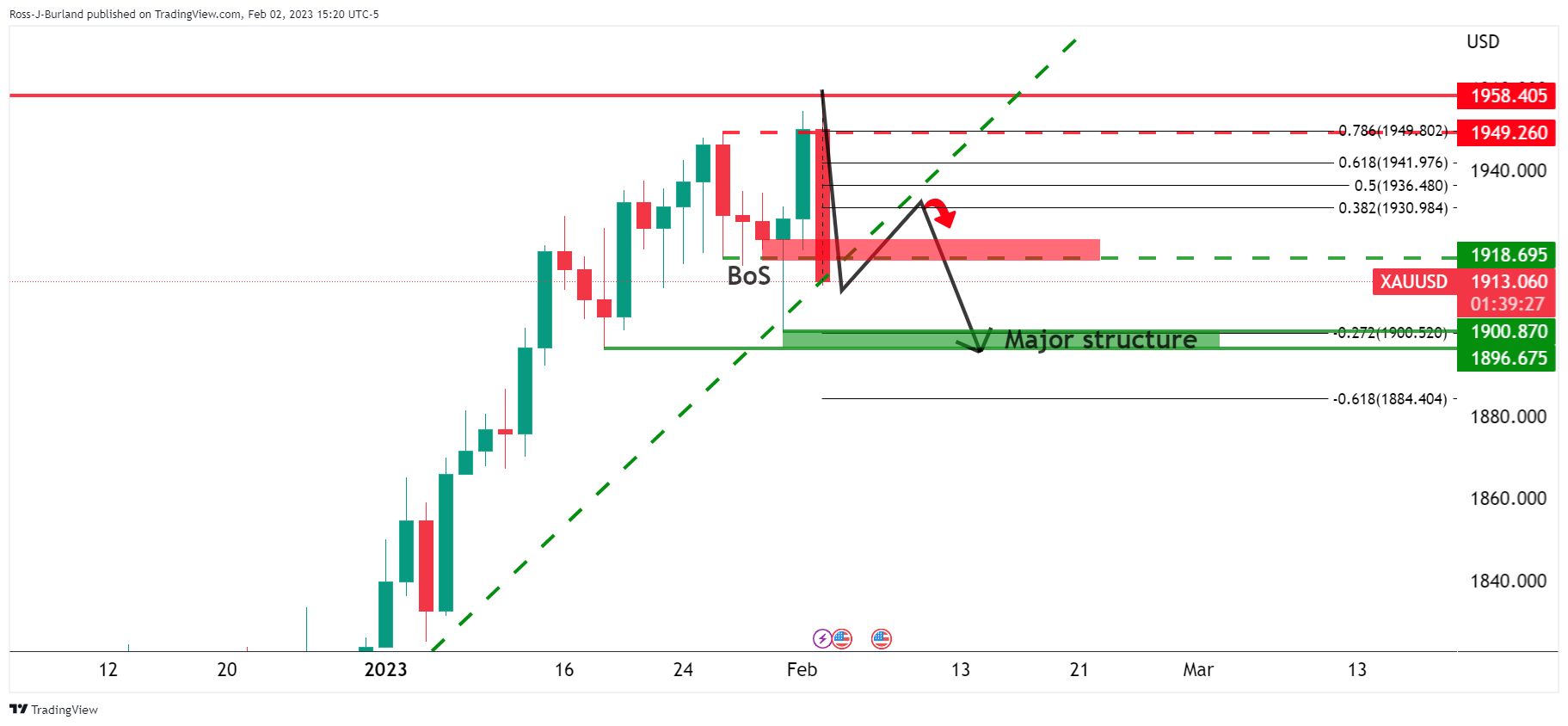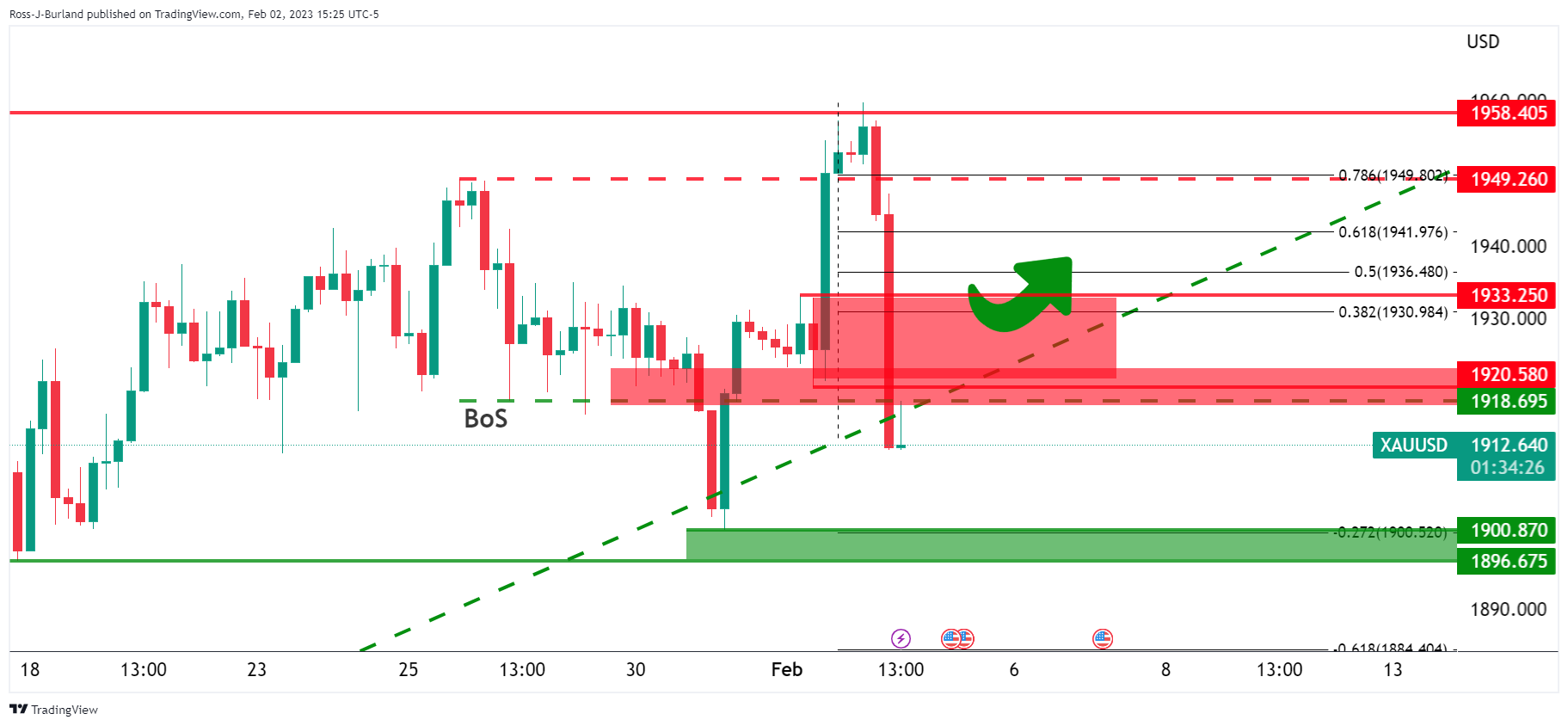- Analytics
- News and Tools
- Market News
- Gold Price Forecast: XAU/USD bears take on critical structure after European Central Bank meeting
Gold Price Forecast: XAU/USD bears take on critical structure after European Central Bank meeting
- Gold price dropped despite the Federal Reserve and European Central Bank combination.
- US Dollar is attempting to correct from multi-week lows.
- United States of America Nonfarm Payrolls could be a major event for the Gold price and US Dollar.
Gold price is tinkering on the edge of a significant blow-off to the downside in the coming days. At the time of writing, XAU/USD is trading down 1.85% and has done most of the leg work for a move much lower. In prior analysis, a downside case has been advocated given the length of the bull rally and the recent breakdown of the Gold price bullish structure is compelling.
The Gold price has dropped from a bull cycle high made on the same day of $1,959.77 and has marked a low of $1,911.87, so far. However, critically, the Gold price has broken $1,918 and should there be a close below here on a daily basis, the bears will have made an impressionable mark on the charts for the week ahead. See below for the technical analysis of the Gold price. M
eanwhile, it has been a game of two halves so far this week with a series of fundamentals playing into both the US dollar and the Gold price. We are now moving into extra time with the Nonfarm Payrolls that will possibly be the deciding factor for both assets.
Federal Reserve and European Central Bank did little to support Gold price
Firstly, the Federal Reserve, Fed, event concluded with a dovish tilt that sank the US Dollar to fresh bear cycle lows of 100.82 as per the DXY index that followed the Federal Reserve's chairman Jerome Powell's dovish rhetoric when he said he is seeing signs of disinflation. Consequently, US Treasury Bond yields were sharply lower, bullish for gold as it offers no interest. The yield on the US 10-year Treasury note dropped to a low of 3.334%.
- Federal Reserve: The rate peak is in sight – Commerzbank
The Federal Reserve raised its key interest rate corridor by 25 basis points to 4.50%-4.75%, as expected. In the view of economists at Commerzbank, the Federal Reserve is unlikely to do much more before it reaches its rate peak and that sentiment was weighing on the US Dollar.
Then, however, the European Central Bank, ECB, came in with a less hawkish than proffered rhetoric that the Euro bulls would have hoped for which sank the Euro, supporting the US Dollar, and propelling the Gold price lower for the day after previously touching a 10-month high.
All in all, Gold price markets are coming around to the fact that while the United States of America's inflation pace may be trending down, the Federal Reserve will have a much harder time getting it down to its desired 2% target considering the labour market shortages, which segues us into the Nonfarm Payrolls on Friday.
Nonfarm Payrolls, expectations for Gold price
The US labour market and Nonfarm Payrolls event is a critical component of the US interest rate outlook. Analysts at TD Securities are projecting payroll gains to have stayed largely unchanged vs December, posting a still solid 220k increase in January. ''Both the Unemployment Rate and average hourly earnings should have remained steady: the former at a decades-low 3.5%, and the latter printing a 0.3% MoM gain,'' the analysts explained. ''Note that the January jobs report will also include important revisions to the establishment survey data for 2022,'' they added.
Such an outcome could provide fuel to the US Dollar's correction from the bear cycle lows and would therefore be expected to weigh on the Gold price. However, a weaker report, analysts at TD Securities warn, or an ''indication of softness will reinforce'' risk sentiment, which could be bullish for the Gold price and bearish for the US Dollar.
Gold technical analysis


The Gold price is breaking down structure, (BoS) on the daily chart and a correction of the daily bearish impulse could result in further selling pressure from the bears. However, a commitment from the Gold price bulls to above $1,920/30 4-hour resistances could leave the bulls in play for the foreseeable future:

All will be revealed for the Gold price over the United States of America Nonfarm Payrolls event on Friday one way or another.
© 2000-2024. All rights reserved.
This site is managed by Teletrade D.J. LLC 2351 LLC 2022 (Euro House, Richmond Hill Road, Kingstown, VC0100, St. Vincent and the Grenadines).
The information on this website is for informational purposes only and does not constitute any investment advice.
The company does not serve or provide services to customers who are residents of the US, Canada, Iran, The Democratic People's Republic of Korea, Yemen and FATF blacklisted countries.
Making transactions on financial markets with marginal financial instruments opens up wide possibilities and allows investors who are willing to take risks to earn high profits, carrying a potentially high risk of losses at the same time. Therefore you should responsibly approach the issue of choosing the appropriate investment strategy, taking the available resources into account, before starting trading.
Use of the information: full or partial use of materials from this website must always be referenced to TeleTrade as the source of information. Use of the materials on the Internet must be accompanied by a hyperlink to teletrade.org. Automatic import of materials and information from this website is prohibited.
Please contact our PR department if you have any questions or need assistance at pr@teletrade.global.















